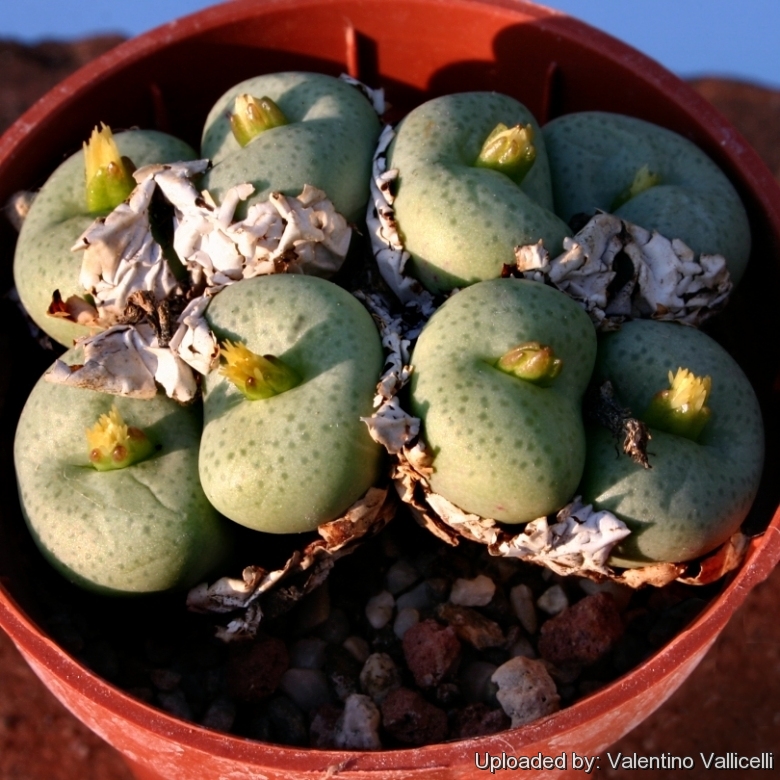
Conophytum truncatum Photo by: Valentino Vallicelli
Locality: Oudtshoorn.
Origin and Habitat: Widespread in the Little Karoo , Western Cape, South Africa. C. truncatum is the the easternmost species.
Type locality: Camanasie
Habitat: C. truncatum are winter grower succulents found in extreme dry areas in shale or quartzite rock crevices (or on gravel) - known as obligate rock dwellers - where they don't have to compete with other plants for water, space and light. They are found generally growing on east, south or west-facing rocky outcrops and slopes - very seldom north-facing (too hot). They are often found growing in amongst mosses and lichens and other shade lovers. They grow, receiving a bit of winter rain, none at summer, but ocean fog moves inland in the evenings, and this moisture sustains a wealth of succulent life in this harsh semi-desert region. Their flowers are pollinated by nocturnal moths.
Synonyms:
See all synonyms of Conophytum truncatum
Common Names include:
RUSSIAN (Русский): Конофитум усеченный
Description: Conophytum truncatumSN|22024]]SN|22024]] is a slow-growing, clump-forming, perennial succulent that forms huge tight mounds of sometimes many hundreds of pea-shaped heads, each one of them consisting of one pair of reduced, fused succulent leaves that get absorbed and regenerated every year. This species comprises many morphological and geographical variant that was early classified as different independent species, but nowadays all this forms are considered part of a multiform species, where each form is linked to others by populations of plants with intermediate characteristics.
Stem: Stemless.
Bodies (paired leaves): It is very variable in form, colour and markings with a sunken fissure at the flattened tip. Stems ranges from small (4-5 mm in diam.) to large (25 mm in diam.!); from completely unmarked specimens to very heavily dark spotted or lined, and from bright green, grey-green, blue-green to having a heavy reddish colouration all often within a single population!
Flowers: The small flowers with spidery petals are nocturnal, and typically in shades of ivory-white, creamy, straw-yellow or salmon and very faint scented.
Blooming: season: Plants flower during the fall months; each blossom opens at night. During the day the flowers close.
Roots: Very rudimentary filamentous root system
Subspecies, varieties, forms and cultivars of plants belonging to the Conophytum truncatum group
 Conophytum multipunctatum Tischer: has pale grey-green bodies closely patterned with very numerous, fine, dots. Distribution: Uniondale Division, Cape Province, South Africa.
Conophytum multipunctatum Tischer: has pale grey-green bodies closely patterned with very numerous, fine, dots. Distribution: Uniondale Division, Cape Province, South Africa. Conophytum peersii Lavis: has pale bluish-green bodies with dark green spots. Distribution: West of Klaarstroom, Western Cape Province, South Africa.
Conophytum peersii Lavis: has pale bluish-green bodies with dark green spots. Distribution: West of Klaarstroom, Western Cape Province, South Africa. Conophytum subglobosum Tischer: differs for the more rounded (not truncated) pair of leaves. Distribution: Little Karoo , Western Cape, South Africa.
Conophytum subglobosum Tischer: differs for the more rounded (not truncated) pair of leaves. Distribution: Little Karoo , Western Cape, South Africa. Conophytum truncatum (Thunb.) N.E.Br.: forms huge tight mounds of hundreds of pea-shaped heads, variable from completely unmarked to very heavily dark spotted or lined. Distribution: Little Karoo , Western Cape, South Africa.
Conophytum truncatum (Thunb.) N.E.Br.: forms huge tight mounds of hundreds of pea-shaped heads, variable from completely unmarked to very heavily dark spotted or lined. Distribution: Little Karoo , Western Cape, South Africa.- Conophytum truncatum subs. viridicatum (N.E.Br.) S.A.Hammer
- Conophytum truncatum var. wiggettiae (N.E.Br.) Rawé
Notes: Plants of the genus Conophytum are also known as 'living pebbles'. During the rest period (the summer months in Europe) a new body forms inside the old, gradually taking all the substances from it until all that remains is the skin, which dries and protects the young plant from the heat of the sun and excess evaporation of water. The resting Conophytum protected by this dry cover resembles a pebble and hence the name 'living pebble'. The growth period of most species is from August to March. The temperature should be about 10 to 12°C
Bibliography: Major references and further lectures
1) Burgoyne, P.M. 2006. Conophytum truncatum (Thunb.) N.E.Br. subsp. truncatum var. truncatum. National Assessment: "Red List of South African Plants" version 2013.1. Accessed on 2014/02/03
2) Nicholas Edward Brown, A. Tischer, M. C. Karsten “Mesembryanthema; Descriptions: With Chapters on Cultivation and General Ecology” L. Reeve, 1931
3) Gordon D. Rowley “The illustrated encyclopedia of succulents” Crown Publishers, 01/Aug/1978
4) James Cullen, Sabina G. Knees, H. Suzanne Cubey “The European Garden Flora Flowering Plants: A Manual for the Identification of Plants Cultivated in Europe, Both Out-of-Doors” Cambridge University Press, 11/Aug./2011
5) Hammer, S. 1993. “The Genus Conophytum - A Conograph.” Succulent Plant Publications, Pretoria.
6) Hammer, S. 2002. “Dumpling and His Wife: New Views of the Genus Conophytum.” East Anglia Engraving Creative Colour Ltd, Norwich, England.
7) Ernst Van Jaarsveld, Ben-Erik Van Wyk, Gideon Smith “Succulents of South Africa: A Guide to the Regional Diversity” Tafelberg Publishers, Limited, 01/lug/2000
8) Heidrun E.K. Hartmann “Illustrated Handbook of Succulent Plants: Aizoaceae A-E” Springer, 2002
9) Werner Rauh “The Wonderful World of Succulents: Cultivation and Description of Selected Succulent Plants Other Than Cacti” Smithsonian Institution Press, 1984
10) Hermann Jacobsen “Lexicon of Succulent Plants” Littlehampton Book Services Ltd. 1974
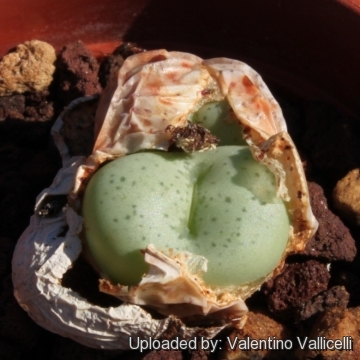 Conophytum truncatum Photo by: Valentino Vallicelli
Conophytum truncatum Photo by: Valentino Vallicelli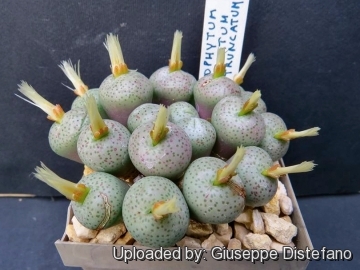 Conophytum truncatum Photo by: Giuseppe Distefano
Conophytum truncatum Photo by: Giuseppe Distefano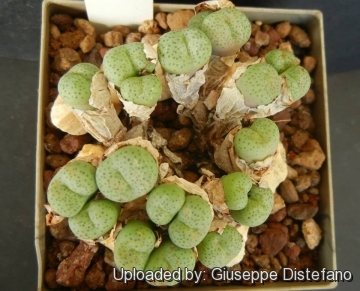 Conophytum truncatum Photo by: Giuseppe Distefano
Conophytum truncatum Photo by: Giuseppe Distefano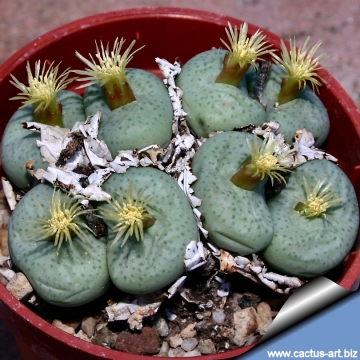 Locality: Oudtshoorn. Photo by: Cactus Art
Locality: Oudtshoorn. Photo by: Cactus Art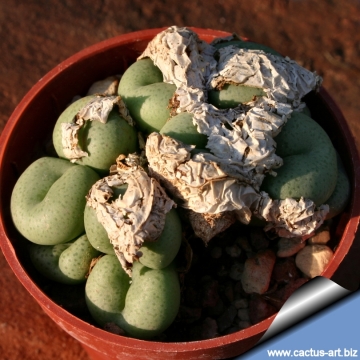 Locality: Oudtshoorn. Photo by: Cactus Art
Locality: Oudtshoorn. Photo by: Cactus Art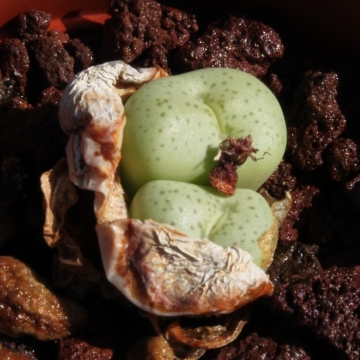 Conophytum truncatum Photo by: Cactus Art
Conophytum truncatum Photo by: Cactus Art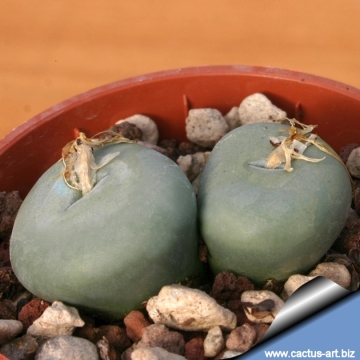 Conophytum truncatum Photo by: Cactus Art
Conophytum truncatum Photo by: Cactus Art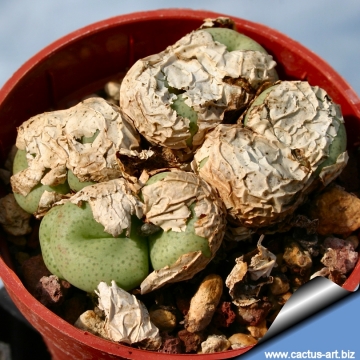 Conophytum truncatum Photo by: Cactus Art
Conophytum truncatum Photo by: Cactus ArtCultivation and Propagation: All the forms of C. truncatum are easy to grow. These plants grow on winter rain and head for summer dormancy. They require little water; otherwise its epidermis breaks (resulting in unsightly scars). Water minimally in summer, (only when the plant starts shrivelling), but it will generally grow even in summer if given water. Water regularly in winter after the previous year's leaves have dried up. Requires good drainage. Keep cool and shaded in summer, it needs full sun or light shade. Hardy to -2°C. Ensure a very good ventilation. Avoid to repot frequently. This plant may stay in the same pot for many years.
Propagation: It can be reproduced both by cuttings and seeds. Take the cutting from a grown-up mother plant. Each cutting must contain one or more heads along with a fraction of root.
Your Photos
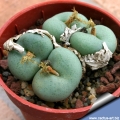
by Cactus Art



















